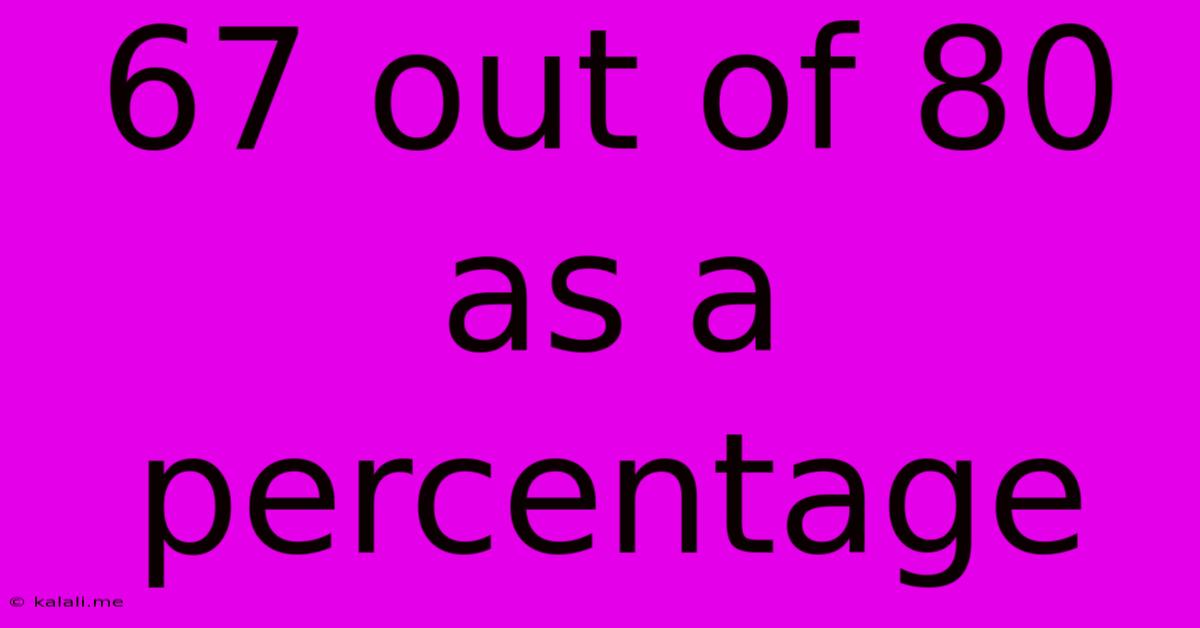67 Out Of 80 As A Percentage
Kalali
May 09, 2025 · 2 min read

Table of Contents
67 out of 80 as a Percentage: A Comprehensive Guide
Calculating percentages is a fundamental skill with applications across various fields, from academic assessments to financial calculations. Understanding how to convert fractions into percentages is crucial for interpreting data and making informed decisions. This article will guide you through calculating 67 out of 80 as a percentage, explain the process, and offer helpful tips for future calculations. This will also cover different methods and contexts where this type of calculation is useful.
What is a Percentage?
A percentage is a way of expressing a number as a fraction of 100. The symbol % represents "per cent" or "out of 100". For instance, 50% means 50 out of 100, or 50/100, which simplifies to 1/2.
Calculating 67 out of 80 as a Percentage:
There are two primary methods to calculate 67 out of 80 as a percentage:
Method 1: Using a Fraction and Decimal Conversion
- Express as a Fraction: Write the given numbers as a fraction: 67/80.
- Convert to Decimal: Divide the numerator (67) by the denominator (80): 67 ÷ 80 = 0.8375
- Convert to Percentage: Multiply the decimal by 100: 0.8375 x 100 = 83.75%
Therefore, 67 out of 80 is 83.75%.
Method 2: Using the Percentage Formula
The percentage formula is: (Part / Whole) x 100 = Percentage
- Identify the Parts: The "part" is 67, and the "whole" is 80.
- Apply the Formula: (67 / 80) x 100 = 83.75%
Again, the result is 83.75%.
Practical Applications and Interpretations:
Understanding how to calculate percentages like this has various applications:
- Academic Performance: If a student scored 67 out of 80 on a test, their score is 83.75%. This percentage provides a standardized way to compare performance across different tests or assignments.
- Business and Finance: Percentage calculations are vital in areas like profit margins, sales growth, and interest rates.
- Data Analysis: Percentages are used extensively to represent proportions and trends within datasets.
- Everyday Life: Discounts, taxes, and tips are commonly expressed as percentages.
Rounding Percentages:
Depending on the context, you might need to round the percentage. For example, you might round 83.75% to 84% for simplicity. However, maintaining the precision (83.75%) is generally preferred in formal settings or when higher accuracy is required.
Conclusion:
Calculating percentages is a valuable skill that simplifies the interpretation of data and facilitates comparisons across different contexts. Whether using the fraction method or the percentage formula, the process is straightforward and easily applicable to various real-world scenarios. Remember to choose the appropriate rounding method depending on the context and desired level of accuracy. Understanding the calculation of 67 out of 80 as 83.75% provides a practical example that can be extended to other percentage calculations.
Latest Posts
Latest Posts
-
The Rate At Which Velocity Is Changing
May 09, 2025
-
Least Common Factor Of 8 And 4
May 09, 2025
-
24 Degrees Celsius Equals What Fahrenheit
May 09, 2025
-
6 Km Equals How Many Miles
May 09, 2025
-
How Many Cups Make 2 3
May 09, 2025
Related Post
Thank you for visiting our website which covers about 67 Out Of 80 As A Percentage . We hope the information provided has been useful to you. Feel free to contact us if you have any questions or need further assistance. See you next time and don't miss to bookmark.